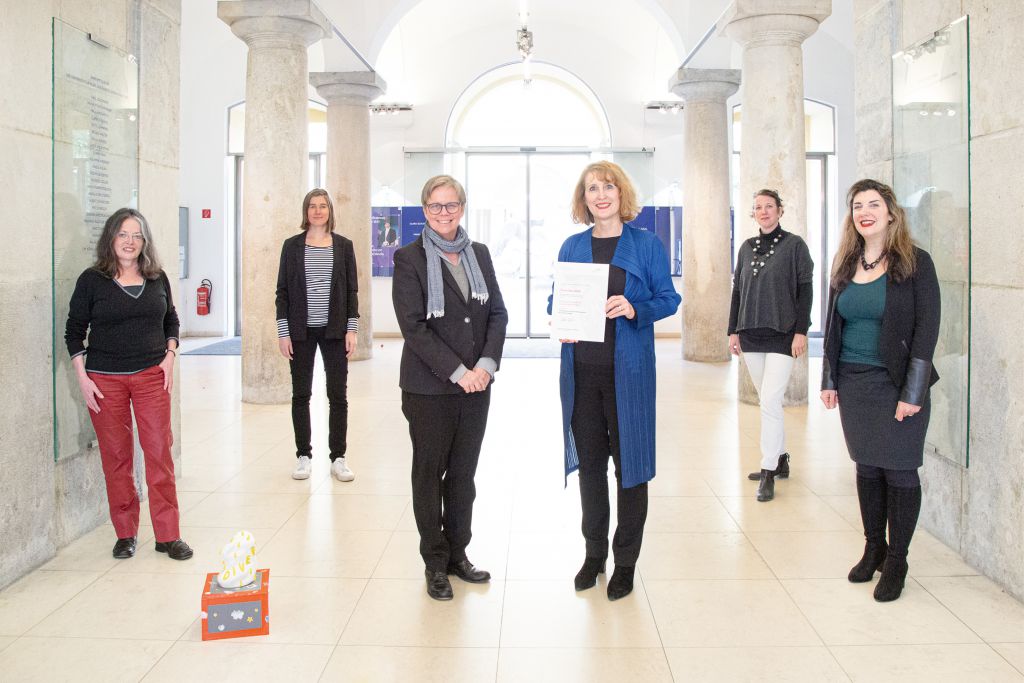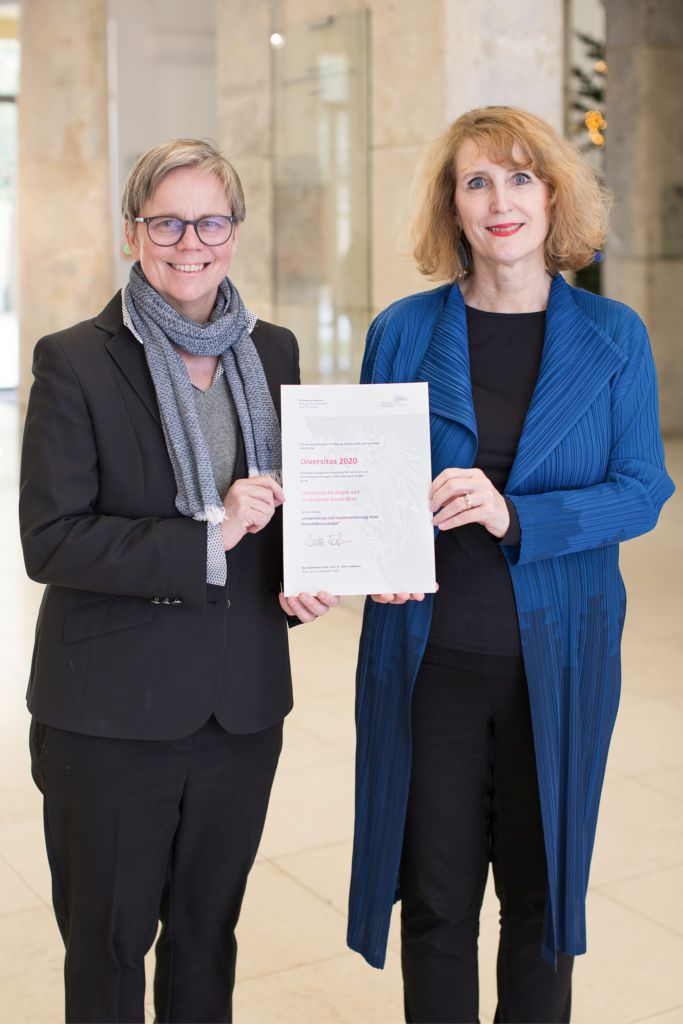Die Freude ist groß, dass es gelungen ist, den Diversitas-Preis des Bundesministeriums für Bildung, Wissenschaft und Forschung erneut an die mdw zu holen. Bereits 2016 wurde die mdw für das Band-Projekt All Stars inclusive – die inklusiv musizierende Band der mdw, die bis heute aktiv ist, mit dem Diversitas ausgezeichnet.
Wofür wird die mdw ausgezeichnet?
Für das ambitionierte Projekt der Entwicklung und Umsetzung einer Diversitätsstrategie als universitätsübergreifender Prozess – mit dem Ziel, zu einem diskriminierungsfreieren Studier- und Arbeitsumfeld beizutragen.

Wer hat diese Strategie initiiert?
Auf Initiative der Vizerektorin für Organisationsentwicklung, Gender & Diversity Gerda Müller war zunächst ein breiter Strategieentwicklungsprozess zum Thema Diversität an der Universität in Gang gesetzt worden. In einem partizipativen Prozess, der zwei Jahre lang (2017–2019) dauerte, haben dazu 80 Personen aus allen (hierarchisch unterschiedlichen) Kernbereichen der Universität – Studierende, Lehrende und Verwaltung – beigetragen. Die Stabstelle Gleichstellung, Gender Studies und Diversität (GGD) hatte diesen Prozess aufgesetzt und durch die Verstärkung einer Diversitätsmanagerin (Ulrike Mayer) wurde dieser ab 2018 intensiviert. 2019 wurde eine auf die Bedürfnisse der mdw zugeschnittene Diversitätsstrategie vom Rektorat verabschiedet und im Mitteilungsblatt veröffentlicht. Seitdem wird an der konkreten Umsetzung der gemeinsam entwickelten Maßnahmen (siehe Abbildung mdw Diversity Scorecard) gearbeitet.
Warum so ein langer und aufwendiger Prozess für die Entwicklung einer Diversitätsstrategie?
Weil es Zeit braucht, wenn sich im Sinne einer demokratischen universitären Gestaltung mehrere Personen aus unterschiedlichen Kernbereichen an einem Prozess beteiligen sollen. Und weil es längere Diskussionen und Auseinandersetzungen sowie eine Perspektivenvielfalt braucht, um gut überlegte und wirksame Schlussfolgerungen ziehen und Handlungen setzen zu können. Und weil heute – in der Gesellschaft des 21. Jahrhunderts – und insbesondere im Bereich der Bildung das Wahrnehmen und Sichtbarmachen von Diversität, von Ungleichheitsdimensionen und der Heterogenität von Identitäten und gesellschaftlichen Positionierungen immer auch bedeutet „gleichzeitig Fragen von Macht und gesellschaftlichem Ausschluss ins Bewusstsein zu rücken“ (Eggers 2001, S. 256). Denn nicht alle Menschen haben den gleichen Zugang zu Ressourcen, Wissen, Positionen oder Institutionen – im Gegenteil: Bis dato „vererbt sich“ Bildung in Österreich bekanntlich.
Es wird nie ein Rezept für das verlässliche Gelingen einer Diversitätsstrategie geben können: Fakt ist aber, dass je mehr Personen sich in einer Expert_inneninstitution wie der Universität an einem solchen Prozess beteiligen, umso mehr Menschen (Universitätsangehörige) können auf die Reise in eine bewusst chancengleichere (Aus)bildungsumgebungs-Zukunft und in wertschätzende Kommunikationsfigurationen und -strukturen an der Universität mitgenommen werden. Und: Je mehr diskriminierungskritisches Wissen durch so einen Prozess in Umlauf gebracht und praktisch angewendet wird, umso nachhaltiger wird ein solcher Prozess sein.
Was bedeutet Diversität sehen lernen und positiv anerkennen?
Vieles haben wir als schwarz oder weiß, als gut oder schlecht inhaliert, starke Werturteile prägen unseren Alltag und schreiben sich dadurch – meist unbewusst – in unsere Wahrnehmung, Sprache, Bilder und Handlungen ein. „Vorurteile und diskriminierendes Wissen sind per Sozialisation, durch Kinderbücher, Filme, Erzählungen von nahestehenden Personen in unsere Köpfe hineingekommen und wirken, wenn wir in der S-Bahn sitzen, Menschen in Supermärkten begegnen oder Einstellungsgespräche führen“ (Schütze/Maedler 2017, S. 41). Einen kritischen Blick auf sich selbst zu richten, anstelle eines „selbstgerechte[n] Blick auf die Anderen (Wiesböck 2018)“, auf die eigenen Sozialisationsbedingungen und den damit einhergehenden Privilegien und Zugehörigkeiten sowie den eigenen bewussten wie unbewussten Vorurteilen ist ein wichtiger erster Schritt in Diversifizierungsprozessen. Denn deren „programmatische Zielsetzung besteht in der Umsetzung von gleichen Rechten und der Realisierung gleicher Zugangsmöglichkeiten, um Ungleichheiten und gesellschaftliche Hierarchien abzubauen“ (Eggers 2001, S. 257). Wenn wir uns kritisch mit Diversität beschäftigen und auseinandersetzen wollen, dürfen wir also nicht nur von Diversität als Vielfalt oder Unterschiedlichkeit (Differenz) reden, sondern müssen auch über Privilegien, Machtverhältnisse und Diskriminierung sprechen. Machtverhältnisse (Rassismus, Sexismus, Klassismus, Ableismus usw.), „wie sie von klein auf gelernt und gelehrt werden, weil sie in Kanons, Bildungsangeboten und Institutionen eingeschrieben sind und immer wieder reproduziert werden“ (Schütze/Maedler 2017, S. 9) müssen benannt, reflektiert und verlernt werden. Eggers spricht in diesem Zusammenhang insbesondere vor dem Hintergrund eines zunehmend von neoliberaler Ökonomisierung und dem Konzept der unternehmerischen Universität geprägten Bildungsklimas von einer Entpolitisierung sowie Harmonisierungspolitik von Diversität, denn die „konsumierbare Diversität (als Zustand) stellt eine weitere Entschärfung des gesellschaftskritischen Potenzials des Veränderungsinstruments Diversifizierung (als Prozess) dar. Ein oberflächliches Verständnis von Diversität als Möglichkeit einer Auflösung oder gar Auslöschung des Spannungsverhältnisses gesellschaftlicher Ungleichheiten trägt zu einer sukzessiven Entpolitisierung bei“ (Eggers 2001, S. 258).
Welche Maßnahmen, die aus der mdw-Diversitätsstrategie entstandenen sind, werden umgesetzt?

Die mdw Diversity Scorecard dient als Roadmap der Diversitätsstrategie: Sie gibt einen Überblick über die geplanten Maßnahmen und ist ein wichtiges Tool, um dranzubleiben und um zu evaluieren, ob diese im Sinne der Zielsetzungen erfolgreich sind und ob/wo es Adaptierungen braucht. Eine Diversitätsstrategie mit dem Anspruch, zu einem diskriminierungsfreieren Studier- und Arbeitsumfeld beizutragen, wird nie ganz abgeschlossen sein können; trotzdem ist es richtig zu sagen, dass sich seit 2017 einiges getan und verändert hat, sowie es auch richtig ist zu sagen, dass noch viel Arbeit vor uns liegt und nicht jede Maßnahme gleich zu einer sicht- und spürbaren Veränderung beiträgt. Sicher ist aber, dass die mdw-Diversitätsstrategie dazu beiträgt, die mdw fairer und demokratischer zu machen.
Literatur
Eggers, Maisha Maureen (2001). „Diversity/Diversität“ in: Arndt, Susan; Ofuatey-Alazard, Nadja (Hrsg.). Wie Rassismus aus Wörtern spricht. (K)erben des Kolonialismus im Wissensarchiv deutsche Sprache. Münster, Unrast.
Mayer, Ulrike (2020). Der Ansatz ‚Kritischer Diversität‘ am Beispiel der Diversitätsstrategie der Universität für Musik und darstellende Kunst Wien, ZDfm – Zeitschrift für Diversitätsforschung und -management, 1–2020, S. 76–82. Open Access: budrich-journals.de/index.php/zdfm/article/view/35175/30100
mdw-Magazin Special zu „Diversität“: mdw.ac.at/magazin/index.php/2019/09/30/special-diversitaet
Schütze, Anja; Maedler, Jens (Hrsg.) (2017). weiße Flecken. Diskurse und Gedanken über Diskriminierung, Diversität und Inklusion in der Kulturellen Bildung. München, kopaed.
Wiesböck, Laura (2018). In besserer Gesellschaft. Der selbstgerechte Blick auf die Anderen. Wien, Kremayr & Scheriau.

